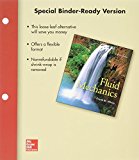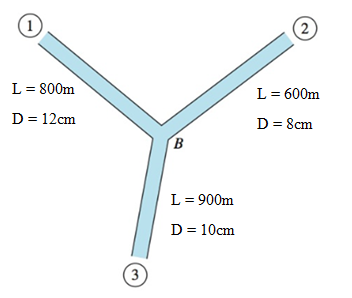
Concept explainers
The flow rate in each pipe and the direction of it.
Answer to Problem 6.125P
Explanation of Solution
Given information:

Pressures in each pipe is equal to,
The fluid is water at
The pipe is made of cast iron.
The pressure drop
In the above equation,
The pressure drop in each pipe can be defined as below,
Consider flow in pipe (1) is towards B and the flow in pipe (3) is away from B and the flow in pipe (2) cannot be confirmed.
Calculation:
For pipe 1,
Assume,
Calculate the roughness ratio,
Calculate the Reynolds’s number,
Find the friction factor,
Calculate the pressure at point B,
Calculate the flow rate,
For pipe 2,
Assume,
Calculate the roughness ratio,
Calculate the Reynolds’s number,
Find the friction factor,
Calculate the pressure at point B,
Calculate the flow rate,
For pipe 3,
Assume,
Calculate the roughness ratio,
Calculate the Reynolds’s number,
Find the friction factor,
Calculate the pressure at point B,
Calculate the flow rate,
Calculate the average value of
The friction factor will not differ a lot; we can use the same friction factor to find relevant velocities,
For pipe (1)
The flow rate is equal to,
The flow in pipe (1) is considered as a flow towards junction B.
For pipe (2)
The flow rate is equal to,
The flow in pipe (2) is considered as a flow away from junction B.
For pipe (3)
The flow rate is equal to,
The flow in pipe (3) is considered as a flow away from junction B.
By further iteration, we an get more accurate answers.
Conclusion:
The flow rates in each pipe is equal to,
Want to see more full solutions like this?
Chapter 6 Solutions
Package: Loose Leaf For Fluid Mechanics With 1 Semester Connect Access Card
 Elements Of ElectromagneticsMechanical EngineeringISBN:9780190698614Author:Sadiku, Matthew N. O.Publisher:Oxford University Press
Elements Of ElectromagneticsMechanical EngineeringISBN:9780190698614Author:Sadiku, Matthew N. O.Publisher:Oxford University Press Mechanics of Materials (10th Edition)Mechanical EngineeringISBN:9780134319650Author:Russell C. HibbelerPublisher:PEARSON
Mechanics of Materials (10th Edition)Mechanical EngineeringISBN:9780134319650Author:Russell C. HibbelerPublisher:PEARSON Thermodynamics: An Engineering ApproachMechanical EngineeringISBN:9781259822674Author:Yunus A. Cengel Dr., Michael A. BolesPublisher:McGraw-Hill Education
Thermodynamics: An Engineering ApproachMechanical EngineeringISBN:9781259822674Author:Yunus A. Cengel Dr., Michael A. BolesPublisher:McGraw-Hill Education Control Systems EngineeringMechanical EngineeringISBN:9781118170519Author:Norman S. NisePublisher:WILEY
Control Systems EngineeringMechanical EngineeringISBN:9781118170519Author:Norman S. NisePublisher:WILEY Mechanics of Materials (MindTap Course List)Mechanical EngineeringISBN:9781337093347Author:Barry J. Goodno, James M. GerePublisher:Cengage Learning
Mechanics of Materials (MindTap Course List)Mechanical EngineeringISBN:9781337093347Author:Barry J. Goodno, James M. GerePublisher:Cengage Learning Engineering Mechanics: StaticsMechanical EngineeringISBN:9781118807330Author:James L. Meriam, L. G. Kraige, J. N. BoltonPublisher:WILEY
Engineering Mechanics: StaticsMechanical EngineeringISBN:9781118807330Author:James L. Meriam, L. G. Kraige, J. N. BoltonPublisher:WILEY





